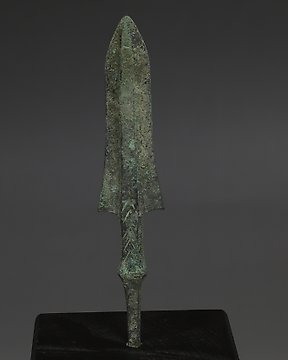
Elamit, mittlere Periode Bronze Pfeilspitze mit Ritzdekor (Ohne Mindestpreis)
Nr. 83275439

Nr. 83275439

Head of Sculpture.
- nice green stone -
CULTURE: Teotihuacán, México
PERIOD: Classic Period, 450 - 650 AD.
MATERIAL: Schist
SIZE: Height 12.5 cm without stand (20,5 cm with stand)
PROVENANCE: Private collection, Windsor, USA, 1960 - 1970. With spanish export license.
CONDITION: Good state of preservation, intact, see photos.
DESCRIPTION:
Teotihuacan «place where men became gods; birthplace of the gods» is the name given to one of the most important Mesoamerican cities in the pre-Columbian era. It was also the place of the dead. Those buried there were teutl, heroes made divine. As with the gods, whom no one could see because they wore masks, the eminences of the Teotihuacan or Toltec upper social layer who were buried there also wore masks for their entry into the underworld. The masks were the link between the deceased and divinity, the means through which they communicated, and which allowed them to reach a heavenly world. Like the masks, figures of considerable dimensions, as well as small, were found in tombs and deposits, representing this elite.
This solemn head may resemble a mask, but it is nothing more than the head of a figure, which a collector refined the break in the neck so that it would not be appreciated and perhaps had it as if it were a mask.
Its physiognomy is typical of sculptures and masks of Teotihuacan; wide and short forehead, it is elongated in shape and rectilinear, a narrow and elongated triangular nose, is located between the two eyes, oval, with long eyebrows marked. The mouth is also elliptical and ajar, with prominent lips. The depressions of the eyes and mouth suggest that it may have originally had shells or stones inlaid for the representation of eyes and teeth. Although the sculpture is carved in green schist, in its original state it could have been painted like others of this type. The long, quadrangular ears and the straight, flat body complete the figure.
The architecture in Teotihuacan reached astounding levels of perfection, not only for the astronomical orientation of the buildings and roads, but also for the forms and decorations. Embedded stone heads representing gods, columns covered with bas-relief of geometric design and monumental decoration are some of the examples of this outstanding work.
Their pottery was also masterfully made. Particularly of note are their incense burners and braziers which had lids heavily decorated and painted in various colours. The representations of the heads of gods and priests with enormous headdresses are characteristic and indicate the skill acquired by the master potters.
This culture was governed by a group of nobles and priests who held power and control over all spheres of society. This elite were masters in many areas of knowledge of the period, such as astronomy, economics, religion, war, art and the calendar, all of which were used to reinforce their power and manage a highly stratified society. Lower down on the social scale were the storekeepers and specialized craftsmen who produced goods of great values for the upper class. At the bottom of the social rung were the peasants who lived in the more humble sections of the city near the farm areas.
Notes:
The seller guarantees that he acquired this piece according to all national and international laws related to the ownership of cultural property. Provenance statement seen by Catawiki.
The seller will take care that any necessary permits, like an export license will be arranged, he will inform the buyer about the status of it if this takes more than a few days.
The piece includes authenticity certificate.
The piece includes Spanish Export License.
So kaufen Sie auf Catawiki
1. Etwas Besonderes entdecken
2. Höchstgebot abgeben
3. Sichere Zahlung durchführen